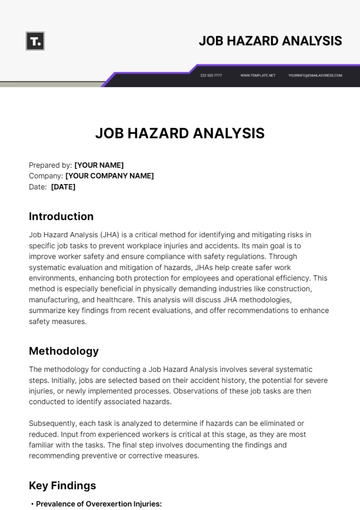Free Job Safety Analysis %252528JSA%252529

I. Introduction
At [Your Company Name], the safety and well-being of our employees are paramount. We are committed to fostering a work environment where every team member feels secure and empowered to perform their duties without unnecessary risk. This Job Safety Analysis (JSA) is a critical component of our comprehensive safety program, serving as a proactive measure to identify, assess, and mitigate potential hazards associated with specific job tasks. By thoroughly evaluating each task, we aim to prevent workplace injuries, reduce operational disruptions, and promote a culture of safety throughout our organization.
The JSA process involves a systematic examination of job tasks, breaking them down into step-by-step procedures to identify potential risks and implement effective control measures. At [Your Company Name], we adhere to all relevant federal and state safety regulations, including those established by the Occupational Safety and Health Administration (OSHA). This analysis not only ensures compliance with these standards but also reinforces our commitment to continuous improvement in workplace safety. Through ongoing collaboration between management, safety personnel, and employees, we strive to create a safe working environment that minimizes risks and enhances overall productivity.
II. Benefits of Job Safety Analysis
Implementing a Job Safety Analysis (JSA) at [Your Company Name] goes beyond regulatory compliance; it is a strategic tool that significantly enhances our workplace safety and operational efficiency. By systematically identifying and addressing potential hazards before they lead to incidents, the JSA process reinforces our commitment to safeguarding our employees. It empowers our workforce by equipping them with the knowledge and tools needed to perform their tasks safely, reducing the likelihood of accidents and injuries.
Moreover, the JSA fosters a culture of safety by promoting continuous dialogue between employees and management. This collaborative approach not only increases awareness of job-specific risks but also highlights areas where additional training or resources may be necessary.
Conducting a JSA can have several benefits, including ensuring a safer workplace and reducing the risk of injury. Other benefits include:
Improved employee awareness of job hazards
Enhanced communication among workers
Identification of additional training needs
Assistance with accident investigation
III. Steps in Conducting a JSA
To effectively conduct a Job Safety Analysis (JSA) at [Your Company Name], it is essential to follow a structured process that ensures thorough hazard identification and risk management. The JSA process is designed to systematically evaluate job tasks and uncover potential safety issues before they lead to incidents. By breaking down the job into manageable steps and assessing each for hazards, we can implement effective controls to prevent accidents and enhance overall safety.
The following steps outline the core process of conducting a JSA:
Step 1: Select the Job to be Analyzed
The first step in developing a JSA is to select the job to be analyzed. While ideally, all jobs should be subjected to a JSA, priority should be given to jobs that meet the following criteria:
High accident frequency and severity
Potential to cause severe or disabling injuries or illnesses
Complex tasks requiring written instructions
New or modified jobs
Infrequently performed jobs or tasks
Step 2: Break the Job Down Into Steps
Break the job into a sequence of steps, describing what is done rather than how it is done. The description focuses on actions, not details, and aims to capture:
The main tasks
Critical steps within tasks
Job Steps | Details |
|---|---|
Step 1 | Preparation |
Step 2 | Perform Task A |
Step 3 | Perform Task B |
Step 4 | Completion and Cleanup |
Step 3: Identify Hazards
Examine each step to identify potential hazards. List all potential hazards and analyze the risks associated with them.
Job Steps | Potential Hazards |
|---|---|
Preparation | Slips, trips, falls, electrocution |
Perform Task A | Muscle strain, falling objects |
Perform Task B | Exposure to hazardous substances |
Completion and Cleanup | Waste disposal hazards, burns |
Step 4: Develop Preventative Measures
Once the hazards have been identified, determine how to eliminate or reduce each hazard. This can involve retraining workers, changing the way tasks are performed, or using different equipment.
Use proper personal protective equipment (PPE)
Control exposure with engineering controls
Implement administrative controls, such as changing work procedures
Job Steps | Hazards | Preventative Measures |
|---|---|---|
Preparation | Slips, trips, falls, electrocution | Ensure clean work area, wear non-slip shoes, utilize ground-fault circuit interrupters |
Perform Task A | Muscle strain, falling objects | Use mechanical aids, wear hard hats |
Perform Task B | Exposure to hazardous substances | Use appropriate PPE, ensure proper ventilation |
Completion and Cleanup | Waste disposal hazards, burns | Use proper disposal containers, wear heat-resistant gloves |
Step 5: Communicate the Results
The final step is to ensure that the findings from the JSA are effectively communicated to all employees who might perform the job. Training sessions, job aids, and regular briefings can be used to convey this information.
IV. Conclusion
Performing a Job Safety Analysis is crucial to ensuring workplace safety. By following these steps, organizations can systematically identify and address potential hazards, thereby reducing the risk of accidents and injuries. Regular review and updating of JSAs are also essential to accommodate changes in procedures, materials, or equipment.
Effective communication and continuous improvement are key to sustaining a safe working environment. JSAs should be a fundamental part of the organization's safety program, promoting a proactive approach to hazard identification and mitigation.
- 100% Customizable, free editor
- Access 1 Million+ Templates, photo’s & graphics
- Download or share as a template
- Click and replace photos, graphics, text, backgrounds
- Resize, crop, AI write & more
- Access advanced editor
Enhance workplace safety with Template.net's Job Safety Analysis (JSA) Template. Fully editable and customizable, this template helps you identify hazards and implement preventive measures. Easily modify it to fit your specific job requirements, editable in our Ai Editor Tool, ensuring a thorough and professional safety analysis.





























